List of Contents
Artificial Intelligence of Things (AIoT) Market Size and Forecast 2025 to 2034
The global artificial intelligence of things (AIoT) market size accounted for USD 171.45 million in 2024 and is predicted to increase from USD 225.89 million in 2025 to approximately USD 2,701.74 million by 2034, expanding at a CAGR of 31.75% from 2025 to 2034. The growth of the market is driven by the increasing demand for intelligent automation, real-time data analytics, and smart infrastructure across industries.
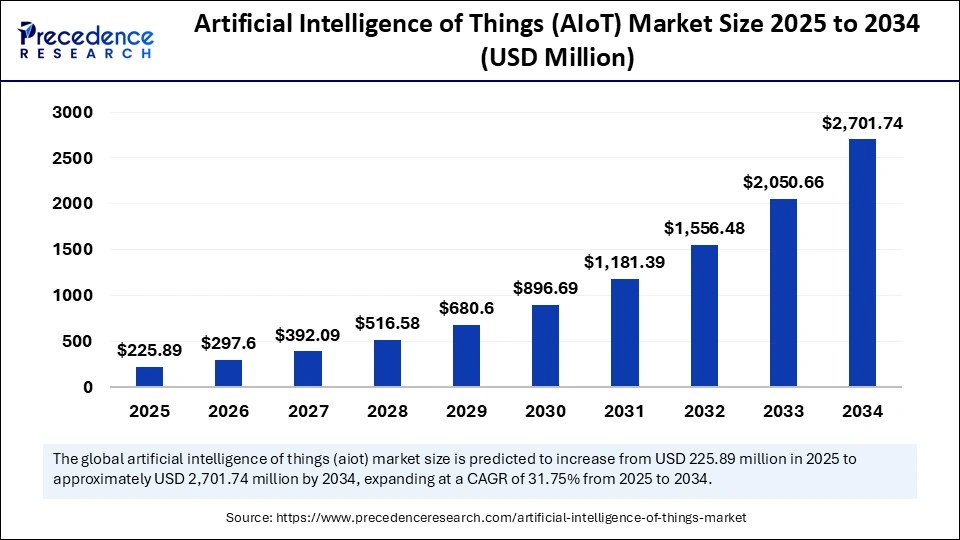
Artificial Intelligence of Things (AIoT) Market Key Takeaways
- The global artificial intelligence of things (AIoT) market was valued at USD 171.45 million in 2024.
- It is projected to reach USD 2,701.74 million by 2034.
- The market is expected to grow at a CAGR of 31.75% from 2025 to 2034.
- North America dominated the global market with the largest share of 43% in 2024.
- Asia Pacific is expected to grow at the fastest rate in the upcoming years.
- By component, the hardware segment held the largest share of 62% in 2024
- By component, the services segment is observed to grow at the fastest CAGR during the forecast period.
- By application, the video surveillance segment captured the biggest market share in 2024.
- By application, the predictive maintenance segment is expected to grow at the fastest CAGR in the upcoming period.
- By deployment, the cloud segment contributed the highest market share of 73% in 2024.
- By deployment, the on-premises segment is emerging as the fastest-growing segment during the forecast period.
- By end use, the B2B segment generated the major market share of 64% in 2024.
- By end use, the B2G segment is expected to grow at the fastest CAGR during the projection period.
- By vertical, the manufacturing segment held a significant market share in 2024.
- By vertical, the healthcare segment is observed to grow at the fastest CAGR during the forecast period.
Role of AI in IoT
Artificial intelligence plays a crucial role in connected devices like IoT, enabling intelligent automation and real-time decision-making. By integrating AI into IoT systems, businesses can glean useful insights from massive volumes of sensor-generated data. Predictive maintenance is made possible through AI, enabling autonomous control and enhancing the operational efficiency of IoT. Advanced features like pattern recognition, anomaly detection, facial/object recognition, and natural language interaction are made possible by AI, which allows IoT devices to go beyond simple data collection. With little assistance from humans, this change turns static networks into self-learning, adaptive ecosystems that continuously maximize performance.
U.S. Artificial Intelligence of Things (AIoT) Market Size and Growth 2025 to 2034
The U.S. artificial intelligence of things (AIoT) market size was exhibited at USD 53.08 million in 2024 and is projected to be worth around USD 852.06 million by 2034, growing at a CAGR of 31.99% from 2025 to 2034.
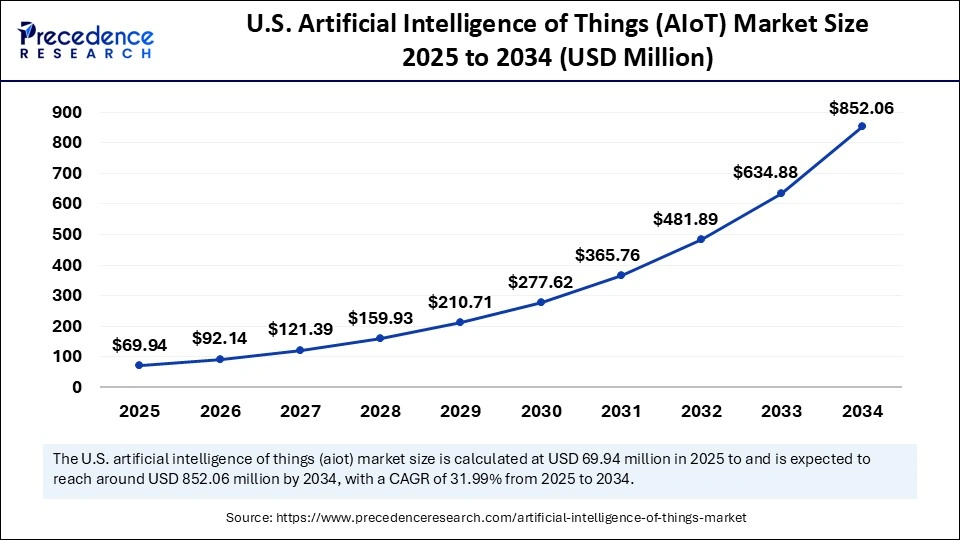
North America dominated the artificial intelligence of things (AIoT) market by capturing the largest share in 2024 due to the well-established technological infrastructure. The region is at the forefront of technological innovations, with a strong presence of leading tech companies. The region is an early adopter of AI and IoT, bolstering market growth. Government funding for edge-AI and chip manufacturing is ensuring uninterrupted component supply. Logistics and freight corridors are increasingly embedding AIoT to ensure real-time operational visibility. Both the public and private sectors are investing in AIoT to improve decision-making. Moreover, supportive government policies encouraging the development of AI technology contribute to regional market growth.
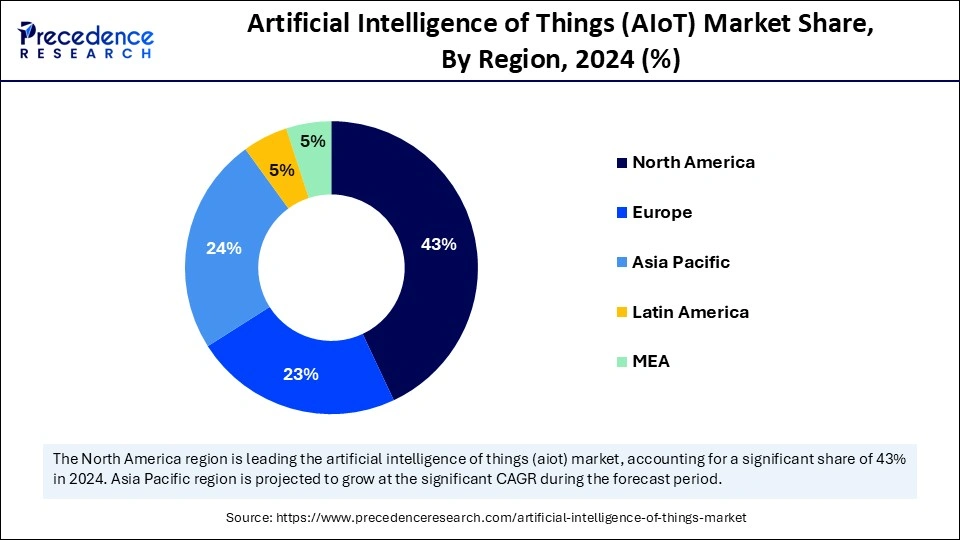
Asia Pacific is emerging as the fastest growing region due to several factors, Firstly, rapid industrialization and a strong focus on industrial automation. Secondly, rising government investments in smart city projects are boosting the adoption of AIoT. Countries like India and China are leading the charge due to rising urban infrastructure development and a strong focus on improving manufacturing capacity. Rapid digital transformation and smart manufacturing initiatives further contribute to regional market growth. Governments of various nations are providing incentives for AI technologies, leading to higher investment in AIoT.
Market Overview
The artificial intelligence of things (AIoT) market is rapidly evolving as organizations seek to harness real-time intelligence from connected devices. The Internet of Things and artificial intelligence are combined to create AIoT, whereby AI algorithms evaluate data from networked devices to facilitate quicker, more intelligent, and self-governing decision-making. Businesses can use predictive maintenance techniques to increase asset utilization, lower operating costs, and boost productivity thanks to this integration. The increasing need for automation, real-time analytics, and smart infrastructure is fueling the expansion of AIoT use in the manufacturing, healthcare, transportation, retail, and energy sectors.
Time-sensitive applications require edge intelligence, which AIoT enables by reducing latency and enabling data processing at the source. The adoption of AIoT is also being accelerated by developments in edge AI chips, more affordable smart sensors, and enhanced connectivity (5G Wi-Fi 6). Businesses are also using AI-based software as a service models and cloud platforms to scale and manage their IoT deployments. The market is still growing quickly despite obstacles like complicated integration, large upfront costs, and data security threats. With more businesses investing in intelligent systems and prioritizing digital transformation, AIoT is positioned to be a key factor in determining the direction of connected self-governing ecosystems in the future.
Artificial Intelligence of Things (AIoT) Market Growth Factors
- Integration of AI with IoT for smarter decision-making: AI enhances IoT systems by enabling predictive analytics, pattern recognition, and automated responses without human intervention.
- Rising adoption of smart homes and cities: Government initiatives and consumer demand for connected energy efficient environments are fueling AIoT deployments in urban infrastructure.
- Increasing use of edge computing: The shift towards edge AI allows faster processing of IoT data locally, reducing latency and improving real-time decision-making.
- Growth in industrial automation and industry 4.0: Manufacturing and logistics sectors are leveraging AIoT for predictive maintenance, asset tracking, and process optimization.
- Expanding healthcare applications: AIoT enables remote patient monitoring, smart wearables, and AI-driven diagnostics, improving healthcare efficiency and accessibility.
- Proliferation of 5G networks: High-speed, low-latency, and 5G networks enhance connectivity and data exchange between AI and IoT devices, expanding their capabilities.
Market Scope
| Report Coverage | Details |
| Market Size by 2034 | USD 2,701.74 Million |
| Market Size in 2025 | USD 225.89 Million |
| Market Size in 2024 | USD 171.45 Million |
| Market Growth Rate from 2025 to 2034 | CAGR of 31.75% |
| Dominating Region | North America |
| Fastest Growing Region | Asia Pacific |
| Base Year | 2024 |
| Forecast Period | 2025 to 2034 |
| Segments Covered | Component, Application, Deployment, End Use, Vertical, and Region |
| Regions Covered | North America, Europe, Asia-Pacific, Latin America, and Middle East & Africa |
Market Dynamics
Drivers
Growing Demand for Real-Time Data Processing and Automation
The rising demand for real-time data processing and automation drives the growth of the artificial intelligence of things (AIoT) market. AIoT makes it possible to instantly analyze data from IoT devices, which aids businesses in making precise and timely decisions. AIoT enables automation in various sectors like logistics, healthcare, and automotive, enhancing operational efficiency and reducing costs. AI algorithms and edge computing lower latency and boost responsiveness. Use cases are growing, ranging from emergency alters in smart cities to dynamic pricing in retail. Real-time AIoT solutions are becoming more and more necessary as digital transformation picks up speed. Real-time AIoT is also being used more and more in fields like public safety and defense for situational awareness surveillance and quick reaction. Processing data at the edge also lessens reliance on the cloud, improving security and compliance.
- In March 2025, ASUS Korea introduced industrial AIoT (Artificial Intelligence of Things) solutions in the Smart Factory +Automation World 2025 (AW 2025) held at COEX in Seoul. The company showcased edge AI systems, single board computers (SBCs), and industrial embedded solutions, emphasizing their potential for use in smart manufacturing and automation environments.
(Source: https://kidd.co.kr)
Surge in Connected Devices Worldwide
Massive amounts of data are being produced by the quick adoption of IoT devices, ranging from industrial systems to smart homes. To process, evaluate, and extract insights from this data, artificial intelligence is crucial. Smartwatches, automobiles, and appliances have AIoT capabilities. AI is being incorporated by businesses into gadgets to increase automation and functionality. The market expansion is supported by the rising adoption of AIoT among consumers and industries. 5G networks are also making it possible for devices to communicate with each other more quickly and smoothly. This enables faster, more dependable, and efficient scaling of AIoT ecosystems.
Restraints
High Implementation and integration costs
Developing and implementing AIoT solutions requires significant investment in hardware, software, and skilled personnel. This high investment creates challenges for businesses with limited budgets. When it comes to AIoT deployment, small and medium-sized businesses frequently face high upfront costs. The burden is increased by costs associated with cloud storage, sensors, edge computing devices, and AI model training. Additionally adding AIoT capabilities to outdated systems raises operating expenses. This expense limits the adoption of AIoT solutions, particularly in price-sensitive markets.
Data Privacy and Security Concerns
AIoT devices collect vast volumes of user and industrial data, making them prime targets for cyberattacks. It can be difficult to guarantee secure data processing storage and transmission, particularly when devices are used in decentralized edge environments. Observance of regulations (e.g. GDPR, HIPAA) introduces more intricacy. Significant financial and reputational losses may result from breaches. Many businesses are, therefore, hesitant to scale AIoT networks. Thus, data privacy concerns hamper the growth of the artificial intelligence of things (AIoT) market.
Opportunities
Expansion of Smart Cities and Infrastructure
In smart cities, AIoT improves environmental monitoring, utility management, public safety, and traffic control. AIoT is being used by governments to enhance citizen services, lower carbon emissions, and optimize urban operations. Real-time leak air pollution, traffic, and infrastructure damage detection are possible with AIoT-enabled sensors. The need for intelligent urban systems is growing faster as cities move toward sustainability and net zero. Governments are collaborating with major tech companies to implement AIoT frameworks throughout cities.
Need for Smart Healthcare Solutions
The rising need for smart healthcare solutions creates immense opportunities in the artificial intelligence of things (AIoT) market. AIoT can be used with smart devices, making it possible to manage chronic diseases, perform predictive diagnosis, and track health in real-time. AIoT enables the development of smart healthcare solutions, such as real-time patient monitoring, AIoT enhances patient outcomes and reduces healthcare costs by enabling remote care. There is a growing need for intelligent wearable devices. Hospitals and consumers can benefit from scalable remote monitoring through AIoT. Additionally, these solutions ease the strain on healthcare systems and lower hospital readmission rates. To keep up with the increasing demand, startups and medical device companies are developing innovative AIoT wearable devices.
Component Insights
Why does the hardware segment dominate the artificial intelligence of things (AIoT) market?
The hardware segment dominated the market with the largest share in 2024. This is mainly due to the increased adoption of IoT devices in various industries, creating the need for sensors. The indispensable interface between the digital and physical world is ensured by hardware. RISC-V accelerators and ARM-based SoCs have been mass-produced, which has reduced per-device TOPS by almost 30% annually. AIoT modules are now bundled into industrial and automotive boards by Tier-1 EMS players as standard features resulting in nearly automatic hardware adoption. Multi-radio device approvals have been expedited by certification bodies (UL CE and FCC), which have sped up time-to-market. Hardware's dominant position in AIoT is further cemented by the growing demand for intrinsic security chips (TPMs PUFs). Advancements in sensor technology further bolstered the growth of the segment.
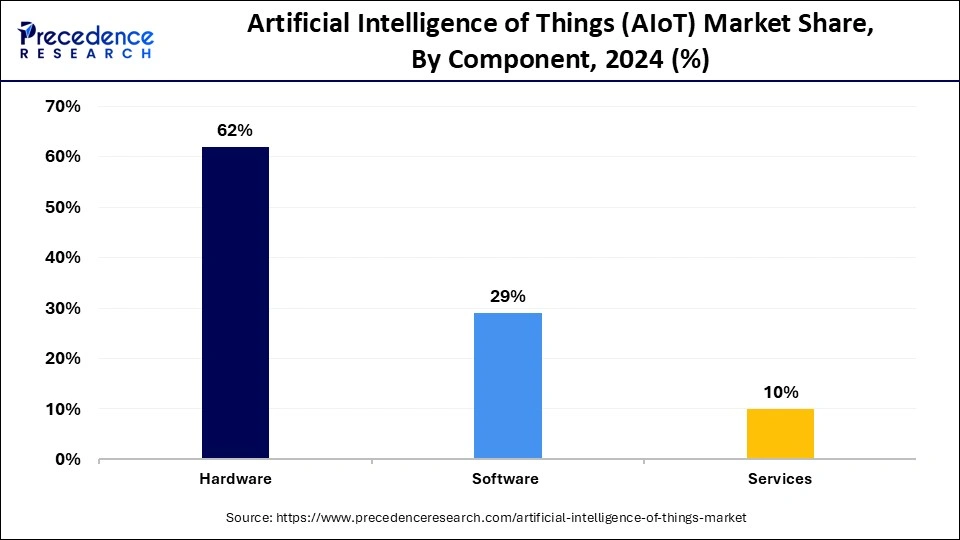
The services segment is observed to grow at the fastest rate during the forecast period, driven by increasing implementation of sophisticated AIoT solutions and the growing need for professional consulting, integration, and support services. Businesses are depending more and more on expert services to guarantee seamless implementation, interoperability with current infrastructure, and real-time AI and IoT system optimization. This increase is also driven by the increasing demand for data management customization and predictive maintenance, which makes services crucial for optimizing ROI and improving operational effectiveness across industries. As the adoption of AIoT solutions increases, so does the need for implementation, training, and maintenance services.
Application Insights
Why did the video surveillance segment dominate the market?
The video surveillance segment dominated the artificial intelligence of things (AIoT) market in 2024, as real-time monitoring and threat detection become more and more important to governments businesses and residential users. Features like facial recognition, anomaly detection, and crowd behavior analysis are some of the ways artificial intelligence (AI) improves. AIoT enables real-time monitoring and automated threat detection, making surveillance systems more efficient. Processing visual data quickly through integration with cloud platforms and edge AI chips improves response times and lessens the workload associated with manual monitoring. Intelligent surveillance systems have become essential parts of retail security, industrial monitoring, public safety, and traffic control systems. IoT and AI together guarantee ongoing learning and flexibility, which gradually increases the intelligence of surveillance systems.
The predictive maintenance segment is expected to grow at the fastest rate in the upcoming period, driven by the rising need to minimize equipment downtime, optimize maintenance cycles, and increase operational efficiency. To predict failures before they happen, AI processes and analyzes sensor data and identify anomalies. In sectors like manufacturing, logistics, utilities, and aviation, predictive maintenance capabilities are essential, boosting the adoption of AIoT. Businesses can minimize expensive unplanned outages, prolong asset life, and lower maintenance costs by enabling timely interventions. AI models gradually increase the accuracy of their predictions by continuously improving them using real-time data. The use of AIoT-based predictive solutions is growing as businesses look to transition from reactive to proactive maintenance models.
Deployment Insights
What made the cloud the dominant segment in the artificial intelligence of things (AIoT) market?
The cloud segment dominated the market with a major revenue share in 2024 owing to its excellent scalability and flexibility. Cloud deployment reduces significant investments in infrastructure, leading to cost savings. SMEs are particularly attracted toward cloud solutions due to their limited budget. Cloud platforms have the ability to handle vast amounts of data generated by IoT devices. Cloud platforms can easily scale up or down as per the requirements. This flexibility is particularly appealing to businesses in industries like healthcare, logistics, and BFSI.
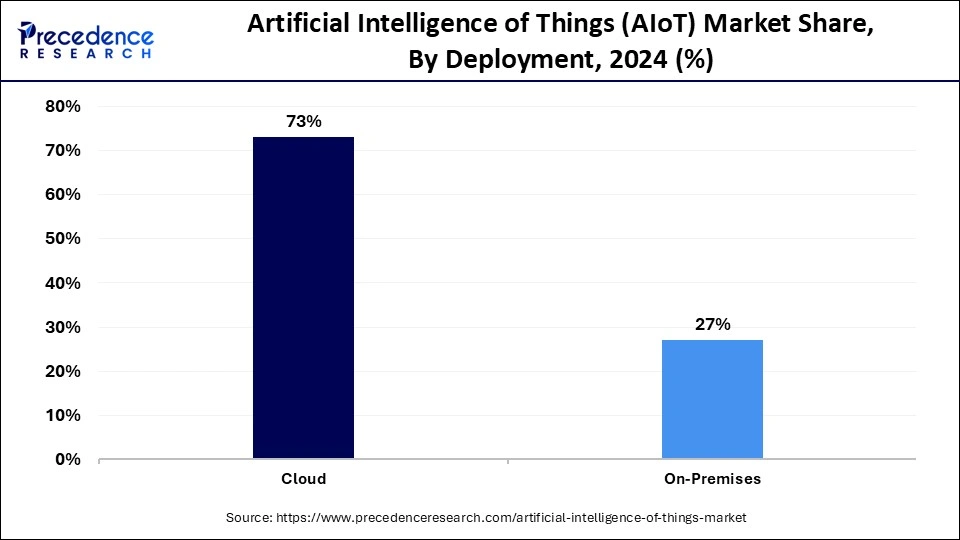
The on-premises segment is expected to grow at the fastest rate in the upcoming period. The growth of the segment is mainly driven by the rising need for data security. Since on-premises solutions are deployed in organizations’ own infrastructure, it allows them to control sensitive data. This, in turn, reduces the risks of data breaches. Stringent regulations regarding data security and privacy encourage the adoption of on-premises platforms.
End Use Insights
Why did the B2B segment dominate the market?
The B2B segment dominated the artificial intelligence of things (AIoT) market by holding the largest revenue share in 2024, driven by economies of scale, cross-plant standardization, and executive KPIs. B2B end users command the lion's share and AIoT spend. Businesses are more likely to invest heavily in AIoT solutions to improve operational efficiency and increase revenue. Potential ROI is higher in B2B. The increased need for data-driven insights encouraged B2B companies to invest in AIoT, as it provides valuable data that can be used to improve processes and services.
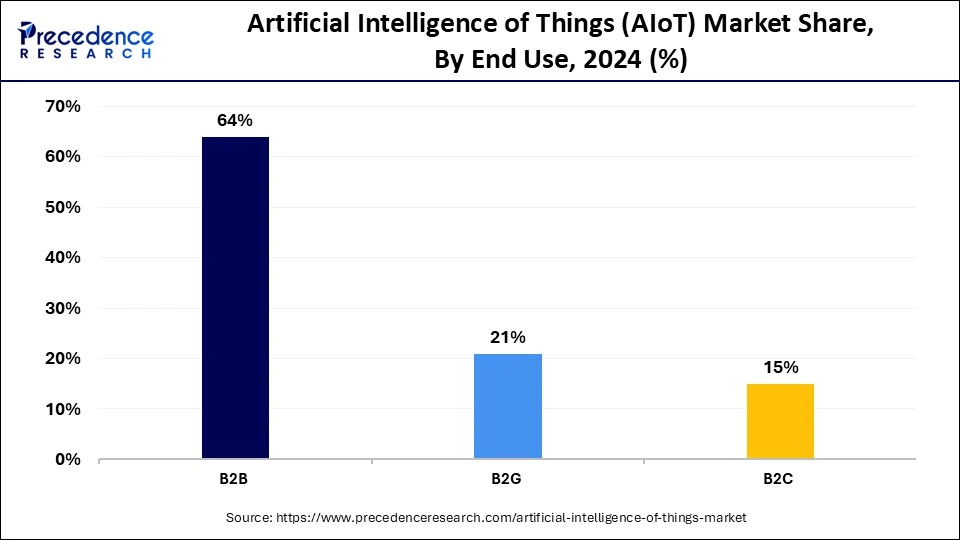
The B2G segment is expected to grow at the fastest rate during the projection period. The rising government investment in smart city projects is a major factor driving the growth of the segment. Governments around the world are investing in AIoT solutions to create smart infrastructure. In addition, governments are deploying AIoT for smart surveillance and emergency response. These solutions enable governments to collect data from various sources and make informed decisions.
Vertical Insights
What made manufacturing the dominant segment in the artificial intelligence of things (AIoT) market?
The manufacturing segment dominated the market in 2024, driven by zero defect goals and supply chain volatility. The increased focus on industrial automation further supports segmental growth. AIoT significantly optimizes operational efficiency by reducing waste generation, encouraging manufacturing companies to invest in AIoT solutions. AIoT has the potential to automate several tasks in the manufacturing line, reducing human errors. Automakers use AIoT to simulate line changes before physical re‑tooling, cutting switchover downtime by 40 %. Similarly, semiconductor fabs employ AI‑enhanced vibration sensors that forecast wafer‑stepper drift days in advance. AIoT monitors manufacturing equipment and identifies defects, reducing downtime. The evolution of Industry 4.0 further bolstered the segmental growth.
The healthcare segment is observed to grow at the fastest rate during the forecast period, driven by increased adoption of telemedicine and AI-assisted diagnostics. AIoT solutions enhance healthcare delivery and patient outcomes by facilitating remote patient monitoring. The rising need for data analytics and data-driven insights is encouraging healthcare organizations to invest in AIoT devices. These devices collect data from various sources, like EHRs and diagnostic equipment, improving decision-making. In addition to this, the rising demand for smart healthcare solutions contributes to segmental growth.
Artificial Intelligence of Things (AIoT) Market Companies
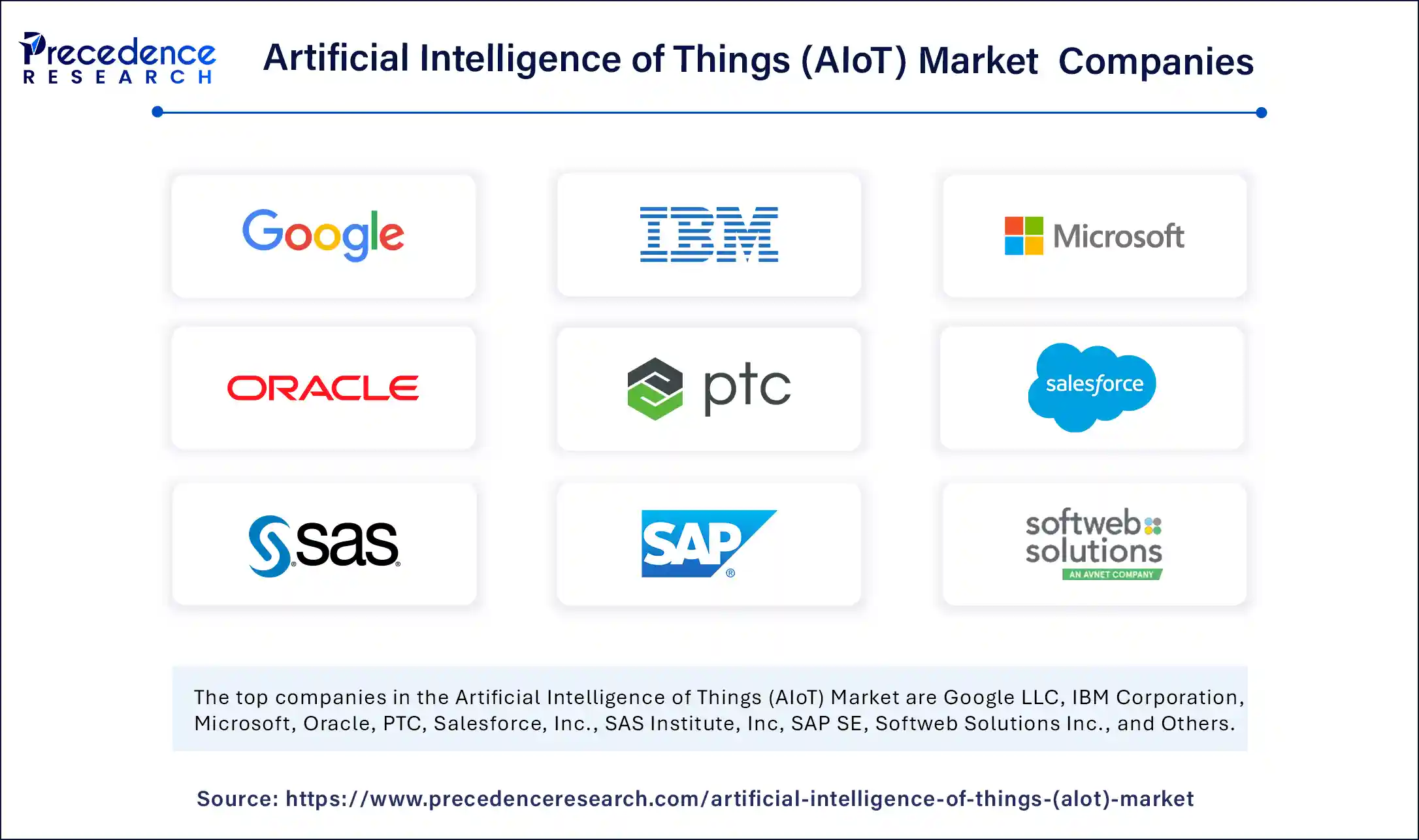
- Google LLC
- IBM Corporation
- Microsoft
- Oracle
- PTC
- Salesforce, Inc.
- SAS Institute, Inc
- SAP SE
- Softweb Solutions Inc.
- Thingstel Tech Solutions India Pvt Ltd
Recent Developments
- On 15 June 2025, Dahua launched the WizColor TiOC Pro series in Australia, featuring full-color night surveillance via AI-powered image signal processing, which enhances clarity in low light and reduces motion blur without additional lighting.
(Source: https://www.akila3d.com) - On 10 June 2025, Eagle Eye Networks released its 2025 Trends Report, highlighting AI-driven facility surveillance improvements including remote monitoring, multi-sensor cameras, and gun detection analytics.
(Source: https://facilitiesmanagementadvisor.com) - In May 2025, N2 Infotech launched an AI-based predictive maintenance solution for elevators, using real-time sensor data to forecast component wear and automate upkeep.
(Source: https://elevatorworld.com)
Segments Covered in the Report
By Component
- Hardware
- Software
- Services
By Application
- Video Surveillance
- Inventory Management
- Predictive Maintenance
- Supply Chain Management
- Others
By Deployment
- Cloud
- On-Premises
By End Use
- B2B
- B2G
- B2C
By Vertical
- Retail
- Agriculture
- Logistics
- BFSI
- Automotive
- Healthcare
- Manufacturing
- Others
By Region
- North America
- Europe
- Asia Pacific
- Latin America
- MEA
For inquiries regarding discounts, bulk purchases, or customization requests, please contact us at sales@precedenceresearch.com
Frequently Asked Questions
Ask For Sample
No cookie-cutter, only authentic analysis – take the 1st step to become a Precedence Research client